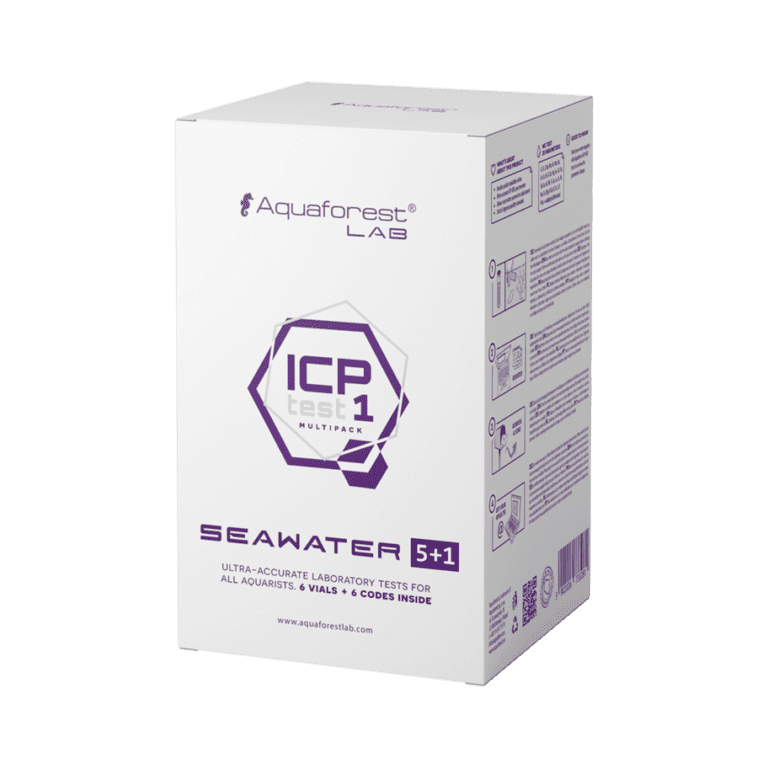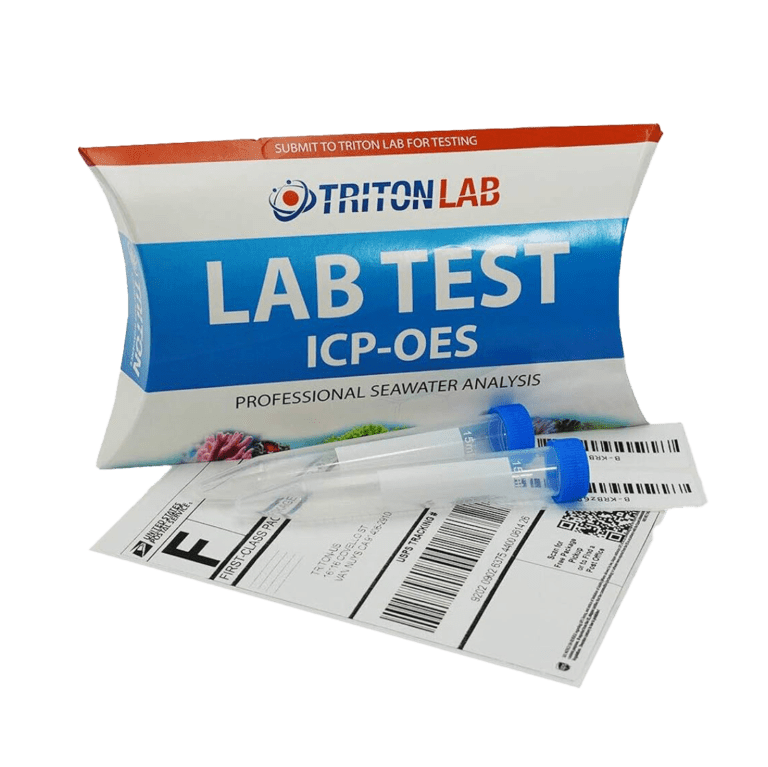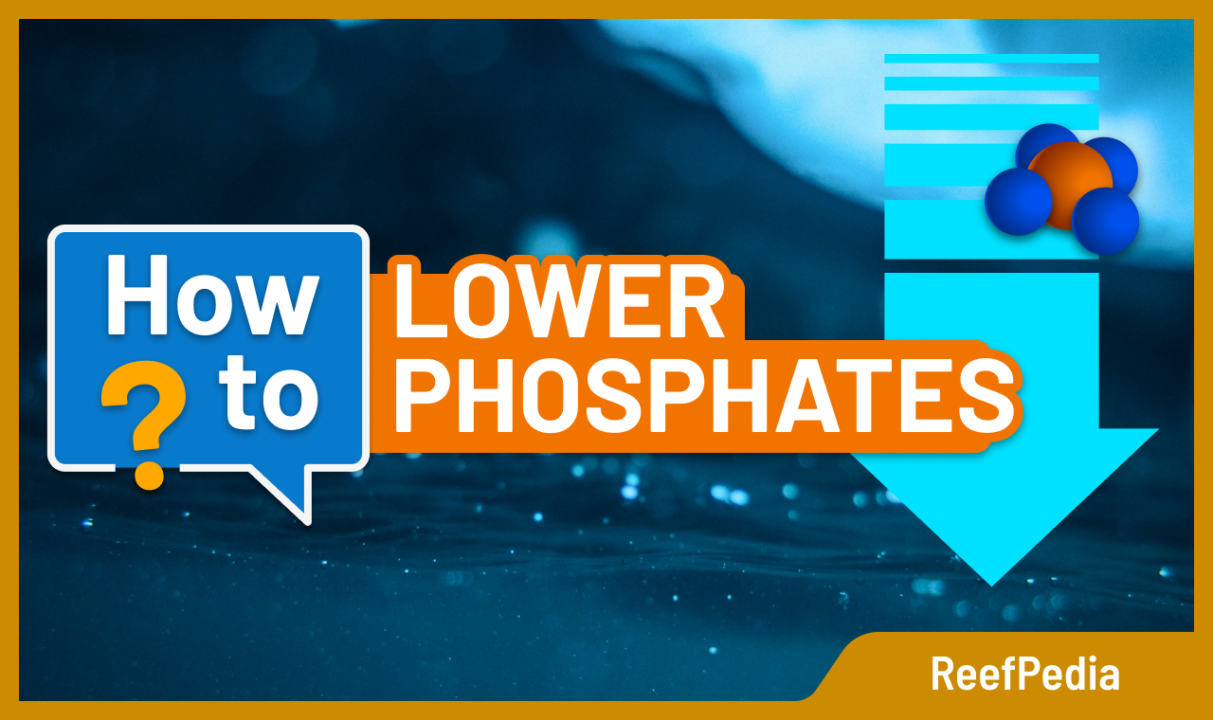Reducing PO4 in an aquarium is certainly an interesting and important topic for many marine aquarists. Too much phosphate in the aquarium can cause algae growth, coral problems as well as dino and cyano formation.
Table of Contents
What is phosphorus?
Phosphorus is essential for the functioning of the cells of many organisms. It is part of nucleic acids, phospholipids and energy-providing compounds, such as ATP. Phosphorus is also essential in the photosynthesis process, it is used by macroalgae and coral symbiotic algae. In a marine aquarium, phosphate (I’ll use the terms ‘phosphorus’ and ‘phosphate’ interchangeably in this article) is supplied with the fish food, the fish then excrete it with their feces. Another source may be the death of living organisms that we don’t notice in time. Such a situation may also increase this parameter. Up to a certain level, phosphates do not pose a direct threat to fish, but increasing levels can be dangerous to corals and can cause a number of other problems in a marine aquarium. You can also find sources of phosphorus in tap water and some salts. Remember that one of the most common causes of too high phosphorus levels is an overfilled tank or throwing unthawed or unrinsed frozen foods into the aquarium. It’s also worth understanding the effect of phosphate on corals. Symbiotic zooxanthellae in corals consume phosphate for their metabolic processes and as a result provide more energy for tissue growth in corals. If phosphates are high for a long time, zooxanthellae may overproduce and turn the coral brown. This is especially evident in SPS, acropora-type corals. On the internet you can also find information that PO4 levels above 0.05 ppm can reduce skeletal mass density in stony corals.What phosphate level is right for your tank?
I personally keep my phosphate levels between 0.02 – 0.08 ppm. My experience comes from running an acropora tank where I manage zooxanthella levels to have better colored corals. On the other hand, there are examples of beautiful tanks where the PO4 level exceeds 0.1 ppm. In my opinion, the selection of corals, the maturity of the tank, the type of filtration, the level of macroalgae will determine what level of phosphate is appropriate for your tank. Therefore, the PO4 level should be selected individually for your tank. This can be done by trial by increasing or decreasing the phosphate level and carefully observing the aquarium. If in any situation we grow unwanted algae, we gradually lower phosphates to inhibit this process. However, remember to maintain the level of PO4 appropriate for the proper functioning of corals.
On the other hand, there are examples of beautiful tanks where the PO4 level exceeds 0.1 ppm. In my opinion, the selection of corals, the maturity of the tank, the type of filtration, the level of macroalgae will determine what level of phosphate is appropriate for your tank. Therefore, the PO4 level should be selected individually for your tank. This can be done by trial by increasing or decreasing the phosphate level and carefully observing the aquarium. If in any situation we grow unwanted algae, we gradually lower phosphates to inhibit this process. However, remember to maintain the level of PO4 appropriate for the proper functioning of corals.
The phosphate cycle in a marine aquarium
Phosphorus, as we have already written, is supplied to the aquarium mainly with fish food, and also comes from their feces. Phosphorus is removed by consumption through active enzymatic transport, where it is food for microorganisms, bacteria and algae, becoming part of their cells in the form of organic compounds.How to measure PO4 in a tank?
Drop tests
Marine aquaristics currently offers a number of opportunities to test phosphate. The easiest way to check this parameter are drop tests.Portable meteres
Another way is a semi-automatic meter based on reagents. The manufacturer of such a device is Hanna. The aquarist takes water, pours in the reagent, mixes the water and places it in the device. After a certain time, we have the result on the display. Hanna has two accuracy ranges for its meters. We recommend the low range ones.Automatic water testing devices
The next category of meters are PO4 testing machines. Reef Factory is in the process of creating such a device – Smart tester. The Smart tester tests the water automatically and provides information to the application. This is a convenient way to monitor your PO4 levels and changes. You can also link measurements to actions and dispense appropriate fluids if your PO4 level is too low or too high.ICP-OES tests
Phosphate can also be checked by the ICP-OES test. This is an accurate measurement made in the laboratory. With the Reef Factory analysis, we get the results in the app with recommendations on what to do if the level is too low or too high.


How to maintain the appropriate level of phosphates?
In the first place, it’s necessary to consider the number of fish and their feeding. As we know, the more fish and the more intensive the feeding, the higher the PO4 level in the tank. If we have already taken care of the appropriate level of the parameter, checked the fish-related issues and reached the desired state, we perform the measurements again. In the event that phosphate exceeds the level that is optimal for us, we must choose one of the methods of lowering phosphorus in a marine aquarium.Skimmer
Protein skimmer reduces phosphate levels. The device removes a whole range of impurities from the water. A good skimmer significantly affects the level of water purity in a marine aquarium.Dosing of carbon polymers
On the market we have a lot of different types of nutrients for bacteria that will reduce both NO3 and PO4. Using this method, we must set the dosing so that PO4 is at the appropriate level. We are not aiming for a PO4 of zero. When setting doses, a series of PO4 tests should be performed, or if we use an automatic test device, we set the appropriate frequency of measurements.Refugium and algae filters
Macroalgae, growing in the refugium, consume PO4 for their growth. From time to time we remove some of the algae to leave room for the growth of a new generation. This causes our phosphates to be continuously removed from the water. When choosing an algae filter or refugium, remember to choose the right size for the tank.Filter media
Another category of tools that we have at our disposal in the fight against PO4 is the popular granular iron oxide (GFO). It binds inorganic phosphates as water flows through the filter or filter sock in which it is placed. Due to the need to manage the flow of water through the medium, we recommend using this medium together with reactors dedicated to this type of solution.Liquid preparations for removing phosphates
The next category of products are liquids using Lanthanum Chloride. Lanthanum combines with phosphate to form microscopic water-insoluble particles of lanthanum phosphate. These particles are then removed from the water by mechanical filtration and a skimmer.Biopellets
Biopellets rotate in a special filter powered by an external pump. They clash, thanks to which a breeding ground for bacteria is released into the water. Bacteria use these grated granules for their metabolic processes, and also take up nitrates and phosphates from the water. The biomass of nutrient-rich bacteria is then removed from the tank by a skimmer.Summary
Phosphate management in a marine aquarium is a multi-layered process. We make sure that tap water is perfectly clean – this is where RO/DI filters come in handy. Then we buy fish in moderation and make sure not to overfeed them. Defrost and rinse the frozen food (putting an unthawed food cube can significantly increase the level of PO4). In the case of phosphates, we should not chase the perfect result, but just watch the tank. If the corals are pumping beautifully, there are no signs of unwanted algae on the rock, then the phosphate level is probably correct. Of course, if we keep soft corals and acroporas together in our tank, we will have to find a balance. You may have to settle for a slightly darker color of acroporas.About the author

Marek Protasewicz
Reefkeeping has been my passion for over 10 years now. I love learning. The hobby has taught me many valuable lessons, patience being the best example. Combining work and passion is my path. I run Crazy Coral, a marine aquarium shop, for a number of years. Building this business from the scratch I learnt from my own mistakes at a heavy cost.
Later I managed a project aimed at development of methods for quick growth of Corals in non-natural conditions. The project was carried out by Get Sales, Poland. Presently, I am responsible for distribution strategy at Reef Factory, of which I am a co-founder. The company produces smart devices for marine aquaristics. The last projects I have been involved in are Social Reef and ReefPedia.
Tagged lower, phosphates



